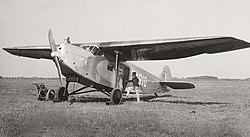Focke-Wulf A 32
| Focke-Wulf A 32 Buzzard | |
|---|---|
 The first A 32 with the serial number 95 |
|
| Type: | Airliner |
| Design country: | |
| Manufacturer: | |
| First flight: |
March 1930 |
| Commissioning: |
July 1930 |
| Production time: |
1930-1932 |
| Number of pieces: |
5 |
The Focke-Wulf A 32 Bussard is a German commercial aircraft built by Focke-Wulf-Flugzeugbau AG in Bremen from the early 1930s.
development
The A 32 was developed on the basis of an inquiry made in January 1930 by the manager of Nordbayerische Luftverkehrsflug GmbH , Theodor Croneiß , who urgently needed a commercial aircraft for six to eight passengers due to production bottlenecks at its previous supplier, Bayerische Flugzeugwerke . Focke-Wulf's designer Wilhelm Bansemir based his project planning on the A 28 Habicht , one of which was built and delivered to Norddeutsche Luftverkehr AG in June 1929 . The work was carried out under great time pressure, as the handover had already been agreed for March 1930. Despite initial problems with the cooler , the appointment was kept and the aircraft, equipped with an L-5 engine according to Croneiß's request , was flown in by the works pilot Cornelius Edzard , whereby, according to Henrich Focke , it should have reached a peak altitude of 3800 m. The aircraft then passed the acceptance flights at the German Aviation Research Institute (DVL) in Berlin-Adlershof and was flown from July of that year with the registration number D – 1910 on the Northern Bavarian Air Transport Flight. He was satisfied and ordered another A 32, which was used from August as the D-1942 .
The three remaining aircraft built were delivered to the DVL, the serial number 113 ( D-2129 ) in August 1931 and the serial number 104 ( D-1997 ) in July 1932. Both broke at the same time in June 1934 during testing. Another A 32 with the serial number 105 received the registration D-2079 in May 1931 and was tested more intensively, whereby the DVL one-flyer Joachim von Köppen certified the model as well as its two predecessors A 20 and A 28 spin safety .
Technical specifications
| Parameter | Data |
|---|---|
| crew | 1-2 |
| Passengers | 6th |
| span | 16.00 m |
| length | 12.20 m |
| height | 3.25 m |
| Wing area | 34.50 m² |
| Preparation mass | 1465 kg |
| Payload | 835 kg |
| payload | 440 kg |
| Takeoff mass | 2300 kg |
| drive | a water-cooled six - cylinder four-stroke in - line engine |
| Type | Junkers L 5 |
|
Starting power nominal power continuous power |
320 hp (235 kW) at 1450 rpm 310 hp (228 kW) at 1400 rpm 280 hp (206 kW) at 1340 rpm |
| Top speed | 190 km / h |
| Cruising speed | 162 km / h |
| Landing speed | 80 km / h |
| Rise time | 5.7 min at 1000 m altitude |
| Service ceiling | 3700 m |
| Range | 790-900 km |
literature
- Manfred Griehl: Focke-Wulf since 1925 . Motorbuch, Stuttgart 2009, ISBN 978-3-613-03006-0 , p. 26 .
- Karl-Dieter Seifert: German air traffic 1926–1945 - on the way to world traffic . In: German aviation . tape 28 . Bernard & Graefe, Bonn 1999, ISBN 3-7637-6118-7 , pp. 300-302 .
- Reinhold Thiel : Focke-Wulf aircraft construction . Hauschild, Bremen 2011, ISBN 978-3-89757-489-2 , pp. 48 .
- Peter All-Fernandez (ed.): Aircraft from A to Z . tape 2 . Bernard & Graefe, Koblenz 1988, ISBN 3-7637-5905-0 , p. 241 .
Web links
Individual evidence
- ^ Karl Ries: Research on the German aviation role. Part 1: 1919-1934 . Dieter Hoffmann, Mainz 1977, ISBN 3-87341-022-2 , p. 143 and 151 .